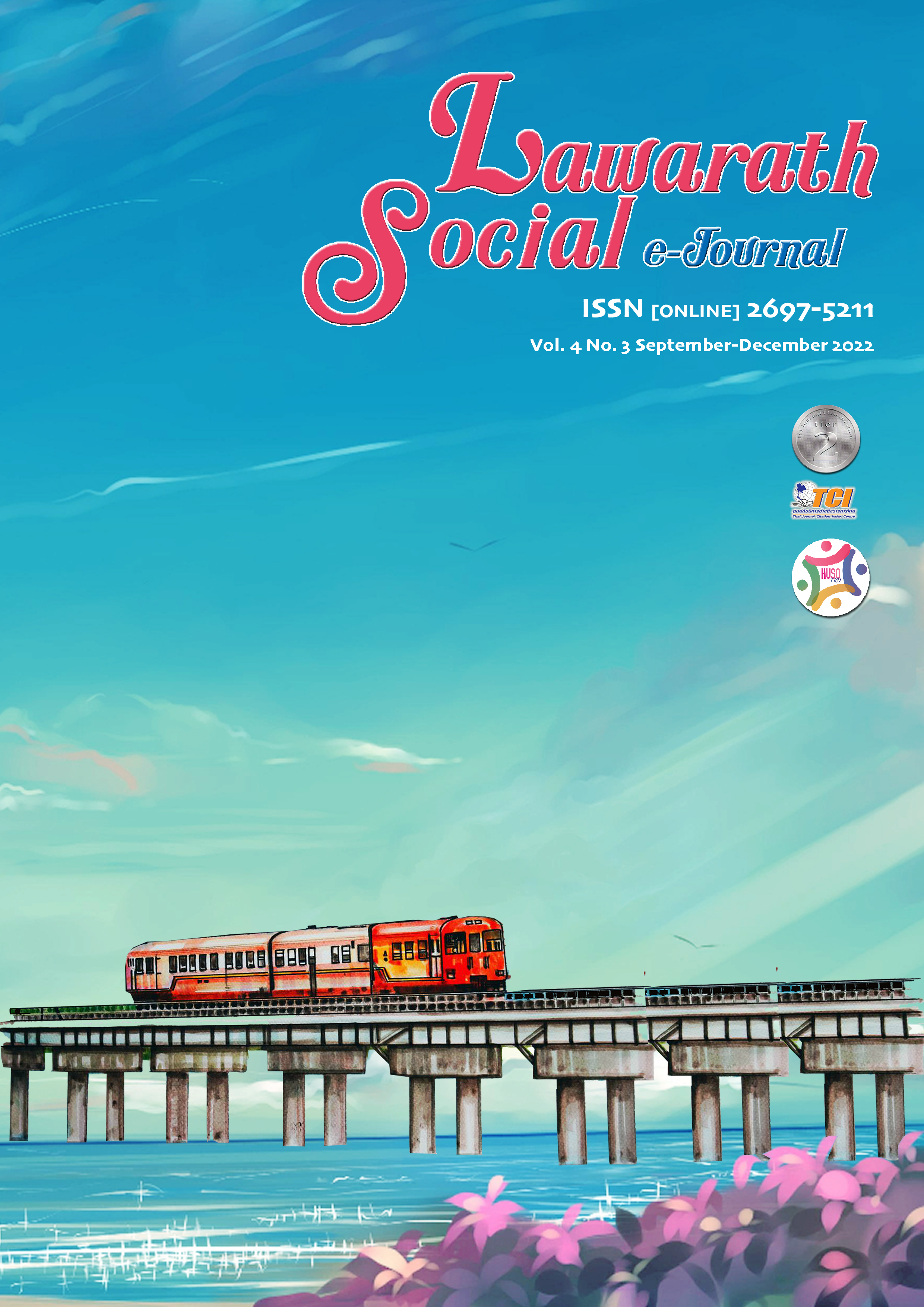A Study of Learning Achievement in Chinese Language for Creative Design by Using Virtual World Technology Combined with The Real World (AR) for Undergraduate Students of Faculty of Fine and Applied Arts, Dhurakij Pundit University
Keywords:
Learning Achievement, Chinese Language, Creative Design, Virtual World Technology and Real World (AR) CombinationAbstract
The objectives of this experimental research were: 1) to study the learning achievement of Chinese Language for Creative Design Course (FA 229) using virtual world technology combined with the real world (AR) and 2) to study the students’ satisfaction toward this special designed course. The samples were 40 first-year students of the Faculty of Fine and Applied Arts, Dhurakij Pundit University studying the Chinese Language for Creative Design Course (FA 229) which were selected by a cluster random sampling. The research instruments were: 1) the course syllabus and lesson plan of Chinese Language for Creative Design Course (FA 229), and they were evaluated by five experts with IOC value of 0.88-1.00; 2) the learning achievement test with a level of difficulty (p) at 0.35-0.83, discrimination (r) at 0.40-1.00, and reliability at 0.87 and 3) the questionnaire to explore the student’s satisfaction with an alpha coefficient at 0.89. The data were analyzed using descriptive statistics including percentage, mean, standard deviation, and statistical hypothesis testing using a t-test for one sample. The results found that: 1) the mean score of the students’ learning achievement of the FA 229 course was at 30.15 and the standard deviation was at 4.03. When compare to the criterion score at 80 %, the overall score was higher than the criterion score which was counted as 32 scores. It was statistical significance at .05 level (sig.000, t= 78.128*); and 2) The overall score of student’s satisfaction towards the FA 229 course was at the highest level (x = 4.56, S.D. = 0.55). The three aspects of the students’ satisfactions arranging in the order from the highest mean to the lowest included the learning activities, teachers and learners.
Downloads
References
เกรียงไกร พละสนธิ. (2559). การพัฒนารูปแบบคลาวด์เลิร์นนิงแบบสะตีมด้วยเทคโนโลยีความเป็นจริงเสริมเพื่อพัฒนาทักษะการสร้างสรรค์ และนวัตกรรมสําหรับนักศึกษาระดับปริญญาตรี. วิทยานิพนธ์ปริญญามหาบัณฑิต มหาวิทยาลัยเทคโนโลยีพระจอมเกล้าพระนครเหนือ.
ใจทิพย์ ณ สงขลา. (2561). การออกแบบการเรียนแบบดิจิทัล. กรุงเทพฯ: โรงพิมพ์แห่งจุฬาลงกรณ์มหาวิทยาลัย.
ดุสิต ขาวเหลือง, และอภิชาติ อนุกูลเวช. (2562). รายงานวิจัยเรื่องการพัฒนาสื่อการเรียนรู้สามมิติแบบมีปฏิสัมพันธ์เสมือนจริงโดยใช้เทคโนโลยีความเป็นจริงเสริม Augmented Reality (AR) เพื่อพัฒนาทักษะการคิดของนักศึกษาอาชีวศึกษาที่มีระดับการคิดอย่างมีวิจารณญาณต่างกัน. ชลบุรี: มหาวิทยาลัยบูรพาและวิทยาลัยเทคนิคชลบุรี.
บุญชม ศรีสะอาด. (2556). วิธีการทางสถิติสำหรับการวิจัย เล่ม 1 (พิมพ์ครั้งที่ 5). กรุงเทพฯ: สุวีริยาสาส์น.
ลิขิต ธีรเวคิน. (2560). มิติใหม่แห่งการเรียนการสอนภาษาจีนในศตวรรษที่ 21. สืบค้น ธันวาคม 10, 2563, จาก https://www.chiangmainews.co.th/page/archives/626374/.
วิวัฒน์ มีสุวรรณ. (2554). การเรียนรู้ด้วยการสร้างโลกเสมือนผสานโลกจริง. พิษณุโลก: มหาวิทยาลัยนเรศวร.
เสาวภา กลิ่นสูงเนิน, สมเกียรติ ตันติวงศ์วาณิช, และศิริรัตน์ เพ็ชรแสงศรี. (2558, กันยายน - ธันวาคม). การพัฒนาสื่อเทคโนโลยีเสมือนจริง เรื่องหลักการทำงานของคอมพิวเตอร์ สำหรับนักเรียนมัธยมศึกษาปีที่ 1. วารสารครุศาสตร์อุตสาหกรรม, 14(3), 288-295.
อุบล ทองปัญญา. (2559). การพัฒนาทักษะการคิดวิเคราะห์ด้วยเทคโนโลยีความเป็นจริงเสริมผนวกวิธีการสอนบูรณาการเทคโนโลยีสารสนเทศในระดับอุดมศึกษา. วิทยานิพนธ์ดุษฎีนิพนธ์ปริญญาดุษฎีบัณฑิต มหาวิทยาลัยเกษตรศาสตร์.
Cirulisa, A., &Brigmanis, K. B. (2013). 3D Outdoor Augmented Reality for Architecture and Urban Planning. Procedia Computer Science, 25(2013), 71-79 Retrieved December 10, 2020, from https://pdf.sciencedirectassets.com/280203/3D. Outdoor Augmented Reality for Architecture and Urban Planning.
Gall, M. D., Borg, W. R., &Gall, J. P. (1996). Educational Research: An Introduction (6th ed.). Maryland: Allyn & Bacon.
Ibanez, M. B., Serio, A. D., Villarán, D., &Kloos, C. D. (2014, February). Experimenting with Electromagnetism Using Augmented Reality: Impact on Flow Student Experience and Educational Effectiveness. Computers & Education, 71(February 2014), 1-13. Retrieved December 10, 2020, from https://www.sciencedirect.com/science/article/abs/pii/S0360131513002571#!.
Lulian, R. (2014, August). Augmented Reality in Education: A Meta-review and Cross-media Analysis. Personal and Ubiquitous Computing, 18(6), 1533-1543.
Ronald, T. A. (1995). Predictive Tracking for Augmented Reality. Doctoral dissertation, University of North Carolina.
Rovinelli, R. J., &Hambleton, R. K. (1976). On The Use of Content Specialists in The Assessment of Criterion-referenced Test Item Validity. in Annual Meeting of the American Education Research. (60th). 1976 April, 19-23. San Francisco, California. 13 Retrieved December 10, 2020, from https://files.eric.ed.gov/fulltext/ED121845.pdf.
Zhou, F., Duh, H. B. L., &Billinghurst, M. (2008). Trends in Augmented Reality Tracking, Interaction and Display: A Review of Ten Years of ISMAR. in IEEE International Symposium on Mixed and Augmented Reality, 2008 September, 15-18. Cambridge.
Downloads
Published
How to Cite
Issue
Section
License

This work is licensed under a Creative Commons Attribution-NonCommercial-NoDerivatives 4.0 International License.



